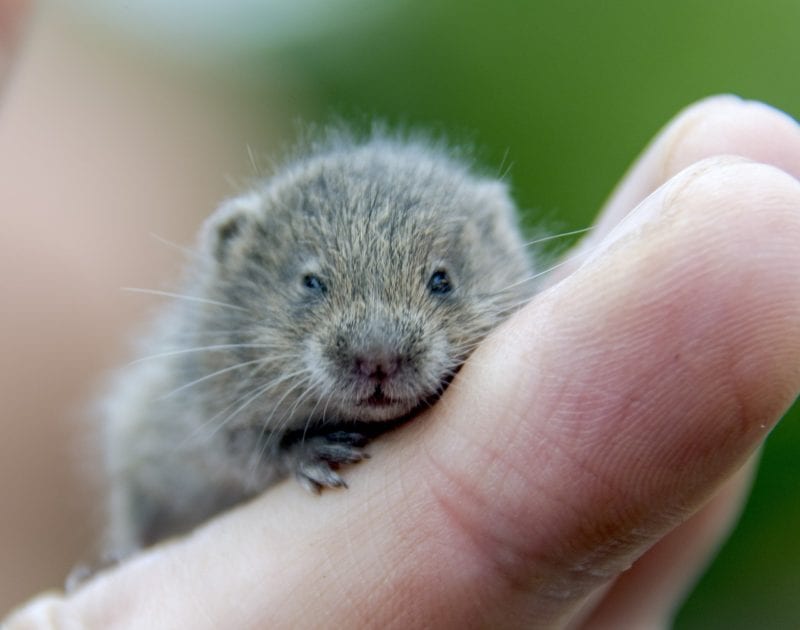Voles are not exactly popular in the garden. They can attack roots and cause considerable damage. But often the true extent of the damage is only visible in the long term. If you want to act quickly to get rid of voles then you need to attack the animals where they feel most comfortable. By making the vole’s burrows uninhabitable, you can show them directly that they are unwelcome in your garden.

These smaller rodents have a very sensitive sense of smell. One way to drive the animals out of the tunnels and your own garden is to spread smelly repellent. Butyric acid is a very popular means to drive the voles out of the garden.
But how exactly does the butyric acid and how can you use this in the fight against the vole?
Contents
Use butyric acid to effectively drive away the vole
What is butyric acid
You may remember butyric acid from school, or you may have heard of the acid in another context. The acid owes its name to its strong odor in concentrated form. The acid smells like rancid butter and is not a pleasant agent for humans or voles.
More surprising, therefore, is the application of butyric acid. This is because it is used in industry, including the perfume industry.
In its original form, butyric acid is colorless and odorless. Only when it reacts with water and oxygen does the typical odor develop. This is often described as an odor reminiscent of vomit.
In pest control, the effectiveness of butyric acid is given by the reaction with a moist soil. So, when using it, you do not have to worry that this smelly agent will be stored somewhere in your house, where it will emit this odor.
It is only when reacting with the damp soil that the characteristic odor appears.
How to use butyric acid against voles
Voles and many rodents have very distinctive senses. They move under the ground and in order to orient themselves there you have a very fine sense of smell and hearing. The eyes are for it in many cases somewhat weaker pronounced, because under the earth no light reaches and they can recognize anyway hardly something.
The very good sense of smell is a good help for them to move around and to discover food sources. This allows them to track down roots under the ground and find their way to edible plants.
But the distinct sense of smell can also become a disadvantage. At least to the disadvantage of the vole, from the point of view of the gardener arises a good opportunity. Because you can use smelly means to fight the vole very effectively.
Give the butyric acid into the vole exit reacts there with the moist soil. From the odorless butyric acid becomes in a short time a real stink bomb, which affects not only humans, but rather still on the vole. Because if you are standing nearby and perceive the smell and find it disturbing, then you should put yourself in the position of the vole, which now gets this smell from close by and perceives it even more intensely.
Therefore, it should not be surprising that the vole will seek the distance as soon as possible. The use of butyric acid is proven to be very effective and you can drive away the vole very easily.
The correct handling of butyric acid
It is true that butyric acid is a potentially hazardous substance. However, it is not very harmful and therefore there are no great precautions to take when handling it.
For your own safety, you should wear gloves when spreading the butyric acid in the aisles. When storing, you should not transfer the butyric acid to another container, but always use the original container.
Otherwise, there would be a risk that the new container would not be airtight. This could cause the butyric acid to react with the oxygen and give off the repulsive odor. For safety’s sake, the container should also be stored in a well-ventilated room. If it does happen that the butyric acid reacts with the oxygen, you are less exposed to danger and the substance can leave.
Application against voles

If you now want to use the butyric acid against the vole then you should proceed as follows.
First put on the gloves, get some cloths, a shovel and get the butyric acid. If you want to be well protected all around, then you can still put on the goggles. To avoid possible irritation of the arms or legs, long clothing is recommended. Now you are fully protected and can start with the actual work.
The basic idea is to drive the vole out of the garden. To do this, you need to cut off any escape route for him except for one possibility. In this way, you can control where the vole will leave its own burrow. Logically, the exit should remain accessible at the edge of the garden. Thus, the vole will be driven to the edge and will quickly run away.
Now you can begin to expose the mounds and passages. This should not take too much time in an ordinary garden. If you proceed too slowly, it is possible that the vole will close the tunnels again. When digging, you should proceed carefully. Otherwise, you run the risk of damaging the tunnels and depriving the vole of an escape route. However, the vole’s burrows are relatively close to the surface, so you should have no trouble finding the burrows here.
After you have dug up all the mounds, you can start sprinkling the cloths with butyric acid. After that, start throwing the cloths with butyric acid into the passages at the hill furthest away from the escape exit. You can easily close the passage again. However, always make sure that you do not destroy the passages.
Now repeat the process, adding the cloths step by step into the vole passages. Do this until you reach the only open exit.
The unbearable smell of butyric acid will now spread within the passage system. The vole will have no choice but to leave the passage system as soon as possible.
Butyric acid is very effective against voles and many gardeners consider it the best and fastest solution in the fight against voles. The method is quick to perform and the vole is not killed. Thus, you have chosen a relatively animal-friendly method to get rid of the vole from your garden.
This method is also popular for moles. So if you also have problems with a mole, you can proceed in the same way.
The only problem could be that the vole does not leave the garden widely, but relatively close again creates a new system of passages. Here you may have to repeat the control and hope that this time the vole will make its new home far enough away.
Alternative methods
If you very urgently want to drive the vole out of the garden and perhaps suspect a whole family in your garden, then it may be useful to combine several methods. If you have very sensitive plants and want to protect them as soon as possible, then you can use even more methods.
Vole gas
The application of vole gas is relatively similar to that of butyric acid. The vole gas is placed in the tunnels and in combination with the soil it reacts and spreads throughout the burrow.
Vole gas is also non-toxic and is used as a deterrent. It is an alternative to butyric acid and there are natural based agents. For example, lavandin oil is used.
But probably the best known is the use of carbide against the vole. All these agents have a high similarity to butyric acid.
Vole poison
If you want to get rid of the rodents for good then you can use a vole poison for this purpose. The use of the poison against voles is legal and you are allowed to kill them. However, you should make sure that there is no mole in the passage and could be killed by the poison.
The poison is applied in combination with a bait. If the vole eats the bait, it absorbs the poison and the lethal effect of the poison occurs.
A combination of coumatetralyl or zinc phosphide is used. These agents are generally suitable for the control of rodents. So if you also suspect common mice in your garden then you can use the poison against them as well.
Protect the plants with vole grids
If you want to prevent your plants from being gnawed by the vole, then you should protect new trees with a grid early on. The grid is placed around the roots of the newly planted tree and is so finely meshed that the vole cannot get to the roots.
Especially when planting a raised bed, you should protect the underside with a vole grid. This is available very inexpensively and can be cut to the appropriate dimensions.
Read more about the use of vole grids.
In any case, butyric acid is still a very good solution in the fight against the vole.

